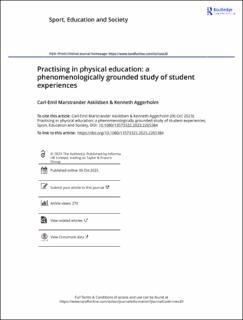| dc.contributor.author | Askildsen, Carl-Emil Marstrander | |
| dc.contributor.author | Aggerholm, Kenneth | |
| dc.date.accessioned | 2024-01-04T15:35:56Z | |
| dc.date.available | 2024-01-04T15:35:56Z | |
| dc.date.created | 2023-10-06T13:34:24Z | |
| dc.date.issued | 2023 | |
| dc.identifier.citation | Sport, Education and Society. 2023, Artikkel 2265384. | en_US |
| dc.identifier.issn | 1357-3322 | |
| dc.identifier.uri | https://hdl.handle.net/11250/3109902 | |
| dc.description | This is an Open Access article distributed under the terms of the Creative Commons Attribution-NonCommercial-NoDerivatives License (http://creativecommons.org/licenses/by-nc-nd/4.0/), which permits non-commercial re-use, distribution, and reproduction in any medium, provided the original work is properly cited, and is not altered, transformed, or built upon in any way. The terms on which this article has been published allow the posting of the Accepted Manuscript in a repository by the author(s) or with their consent. | en_US |
| dc.description.abstract | This study investigates 10th-grade students’ experiences with physical education (PE) units informed by a pedagogical model called the practising model (PM). We apply a theoretical framework that integrates core concepts from phenomenology with empirical investigations of experience by focusing on structures of human existence, such as embodiment, intentionality, intersubjectivity, affectivity, and temporality. Based on qualitative data from observations of 21 PE sessions, 22 student interviews, and the students’ diaries, we discuss three key findings: First, we look into the relational aspect of practising and discuss how three levels of intersubjectivity – primary, secondary, and narrative – affect students’ experiences. Second, we investigate the bodily aspect of practising by discussing how a dialectic orientation between deliberation, conscious reflections, and embodied actions led to a creative and awakened goal-directedness that nurtured future-oriented and meaningful repetitions. This supported the development of new movement capabilities and helped students discover new ways of experiencing meaning in movement landscapes. Lastly, we address the emotional aspects of practising, where we found that affective modes such as excitement, joy, and uncertainty worked as affordances that provided direction and meaning. Uncertainty turned out to be the essential mode to handle for both students and the teacher. Agency, just right challenges, in-depth reflections, creativity, problem-solving strategies, felt progress, and active repetitions over time emerged as crucial components for keeping uncertainty within the productive span. In short, the findings from this study qualify our knowledge of the experience of practising and throw new light on the process in which educative and meaningful experiences can grow from the practising of capabilities. | en_US |
| dc.language.iso | eng | en_US |
| dc.subject | meaning | en_US |
| dc.subject | pedagogical models | en_US |
| dc.subject | phenomenology | en_US |
| dc.subject | physical education | en_US |
| dc.subject | practising | en_US |
| dc.title | Practising in physical education: A phenomenologically grounded study of student experiences | en_US |
| dc.type | Peer reviewed | en_US |
| dc.type | Journal article | en_US |
| dc.description.version | publishedVersion | en_US |
| dc.rights.holder | © 2023 The Author(s) | en_US |
| dc.source.pagenumber | 15 | en_US |
| dc.source.journal | Sport, Education and Society | en_US |
| dc.identifier.doi | 10.1080/13573322.2023.2265384 | |
| dc.identifier.cristin | 2182466 | |
| dc.description.localcode | Institutt for lærerutdanning og friluftslivsstudier / Department of Teacher Education and Outdoor Studies | en_US |
| dc.source.articlenumber | 2265384 | en_US |
| cristin.ispublished | true | |
| cristin.fulltext | original | |
| cristin.qualitycode | 2 | |
